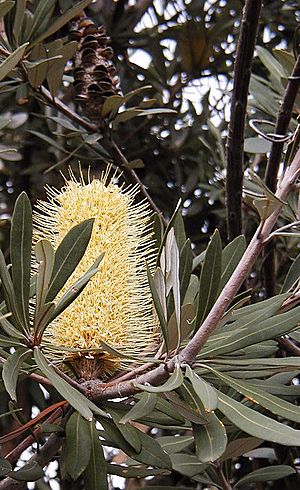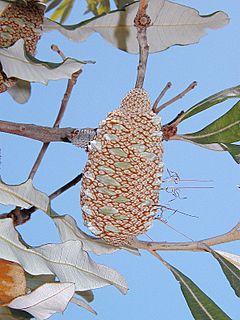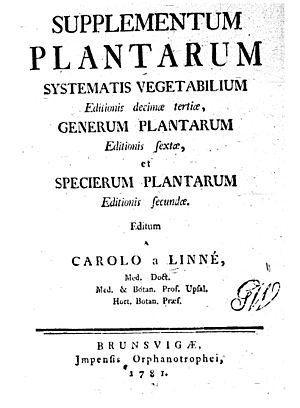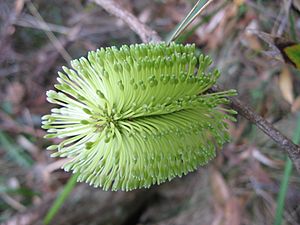Taxonomy of Banksia integrifolia facts for kids
Quick facts for kids Banksia integrifolia |
|
|---|---|
 |
|
| Banksia integrifolia subsp. integrifolia | |
| Scientific classification | |
| Kingdom: | |
| (unranked): | |
| (unranked): | |
| Order: | |
| Family: | |
| Genus: | |
| Subgenus: | |
| Section: | |
| Series: | |
| Species: |
B. integrifolia
|
| Binomial name | |
| Banksia integrifolia L.f.
|
|
| Subspecies | |
| Synonyms | |
|
|
The taxonomy of Banksia integrifolia is like a big family tree for this plant. It has a long and sometimes confusing history. This is because the plant can look very different depending on where it grows. Also, it looks a lot like some of its close relatives. Sometimes, different types of Banksia even mix together to create new hybrid plants. Early studies using dried plant samples also added to the confusion.
Today, scientists divide this plant into three main groups called subspecies: B. i. subsp. compar, B. i. subsp. integrifolia, and B. i. subsp. monticola. Recent studies using DNA have shown that this way of dividing them makes sense.
For a long time, scientists agreed on where B. integrifolia fit in the Banksia family. It was placed in a group called subg. Banksia, then sect. Banksia, and finally ser. Salicinae. But new DNA studies are making scientists rethink this arrangement. A new way of organizing the Banksia family tree, based on how plants are related, might be published soon.
Contents
What is Banksia integrifolia?
Banksia integrifolia, also known as the Coast Banksia, is a very common type of Banksia. You can find it in many places, from Victoria all the way to Central Queensland in Australia. It grows in many different habitats, from sandy dunes by the ocean to high up in the mountains.
This plant can look quite different depending on where it lives. But usually, it's a tree that can grow up to 25 metres (82 ft) tall. Its leaves are dark green on top and white underneath. This contrast looks really cool on a windy day!
The Coast Banksia is a tough and useful Australian native plant. People often plant it in their gardens. In its natural areas, it's a popular choice for parks and street trees. It's also used to help new plants grow in areas that need revegetation and to stop sand dunes from moving. Because it's so tough, scientists have even looked into using it to help grow cut flowers. However, some worry it might spread too much and become a weed outside its natural home.
How was Banksia integrifolia discovered?
The first time scientists collected B. integrifolia was in 1770. Sir Joseph Banks and Dr Daniel Solander were naturalists on Captain James Cook's ship, the Endeavour. They landed in Australia for the first time on April 29, 1770. Cook later named this spot Botany Bay because of all the plants Banks and Solander found there.
For the next seven weeks, Banks and Solander collected thousands of plant samples. Among them were the first samples of a new group of plants. This group would later be named Banksia to honor Sir Joseph Banks.
Every plant sample collected on the Endeavour trip was drawn by the artist Sydney Parkinson. When the Endeavour returned to England in 1771, Banks' samples became part of his plant collection in London. Artists then painted watercolours based on Parkinson's sketches. Banks wanted to publish all his findings in a book called "Banks' Florilegium". But for different reasons, the book was never finished. It took ten years before any of the Banksia species were officially described.
Early Names and Classifications
The group of plants called Banksia was finally described by Carolus Linnaeus the Younger in April 1782. He published his work in a book called Supplementum Plantarum. Linnaeus described four Banksia species. He named them based on the shape of their leaves. The species with smooth, unbroken leaf edges was named integrifolia. This name comes from the Latin words integer, meaning "entire" or "whole", and folium, meaning "leaf". So, the full scientific name is "Banksia integrifolia L.f."
For the next two centuries, scientists kept changing how they defined B. integrifolia. This caused some confusion. For example, in 1788, Joseph Gaertner described a plant he called B. spicata. Later, in 1810, Robert Brown said that B. spicata was actually the same as B. integrifolia.
In 1800, Antonio José Cavanilles described several new Banksia species. These were based on samples collected in New South Wales. Two of these, B. oleifolia and B. glauca, were also later found to be the same as B. integrifolia.
In 1810, Robert Brown described 31 known Banksia species in his book Prodromus Florae Novae Hollandiae et Insulae Van Diemen. He divided the Banksia group into two main parts. He put B. integrifolia in the group called Banksia verae, which means "True Banksias". Brown also described a new species called B. compar. This plant is now considered a subspecies of B. integrifolia. Another plant, B. paludosa, is a close relative that was once thought to be a type of B. integrifolia.
By 1856, there were 58 known Banksia species. Carl Meissner divided Brown's "True Banksias" into four smaller groups based on their leaves. He placed B. integrifolia in the group called Salicinae. He also divided B. integrifolia into three varieties based on leaf size and shape. However, these varieties were later found to be incorrect.
In 1870, George Bentham published a detailed review of Banksia in his important book Flora Australiensis. He changed Meissner's groups. B. integrifolia was placed in a section called Eubanksia along with B. marginata and B. dentata. The number of recognized Banksia species was reduced from 60 to 46. B. compar was considered the same as B. integrifolia, and B. paludosa was made a variety of B. integrifolia. Today, B. compar is a subspecies of B. integrifolia, but B. paludosa is now its own species again.
A big change happened in Banksia naming in 1891. Otto Kuntze argued that the name Banksia had been used before. He tried to rename all Banksia plants to Sirmuellera. So, B. integrifolia would have become Sirmuellera integrifolia. This challenge failed, as did a similar one by James Britten in 1905. Britten suggested the name Isostylis. But in 1940, the name Banksia was officially protected, so no one could challenge it again.
How Banksia integrifolia was Classified in the 20th Century
In 1913, Frederick Bailey gave Brown's B. compar a new rank: B. i. var. compar. This was the first time a smaller group within B. integrifolia was widely accepted. In 1994, Kevin Thiele raised it to subspecies rank, calling it B. i. subsp. compar. This name is still used today. When B. i. subsp. compar was named, it automatically created the name B. i. subsp. integrifolia for the original type of the plant.
The most accepted way of classifying Banksia for a long time was in Alex George's 1981 book, The genus Banksia L.f. (Proteaceae). George updated the existing names and also described new species and subspecies. He added a new variety of B. integrifolia, called B. i. var. aquilonia. This was later made a subspecies by Thiele in 1994, and then a full species, Banksia aquilonia, by George in 1996.
A third subspecies of B. integrifolia was first noted in Gwen Harden's 1991 book, Flora of New South Wales. Harden recognized a new subspecies but didn't name it, just called it "B. i. subsp. A". Three years later, Thiele confirmed it was a subspecies and named it B. i. subsp. monticola.
In 1996, Kevin Thiele and Pauline Ladiges published a new way to arrange Banksia plants. They used a method called cladistics, which looks at how different species are related. Their new arrangement was quite different from George's. Thiele and Ladiges kept B. integrifolia in the Salicinae group. They then divided this group into two smaller parts. The plants in the first part, including B. integrifolia, seem to be closely related. They can even create natural hybrids where they grow together. This arrangement was used until 1999. Then, George went back to his 1981 arrangement in his book for the Flora of Australia series. He felt there wasn't enough proof for the new divisions.
George's Classification System

Until recently, the most accepted way to classify Banksia was George's system from 1999. In this system, B. integrifolia is placed in:
- Banksia subg. Banksia: because its flowers grow in the typical Banksia spike shape.
- Banksia sect. Banksia: because of its straight styles (part of the flower).
- Banksia ser. Salicinae: because its flower spikes are shaped like cylinders.
Here's a simplified look at where B. integrifolia fits in George's classification of Banksia:
- Genus Banksia
- Subgenus Isostylis
- Subgenus Banksia
- Section Oncostylis
- Section Coccinea
- Section Banksia
- Series Grandes
- Series Banksia
- Series Crocinae
- Series Prostratae
- Series Cyrtostylis
- Series Tetragonae
- Series Bauerinae
- Series Quercinae
- Series Salicinae
- B. dentata - B. aquilonia - B. integrifolia - B. plagiocarpa - B. oblongifolia - B. robur - B. conferta - B. paludosa - B. marginata - B. canei - B. saxicola
Modern Discoveries in the 21st Century
Since 1998, Austin Mast has been publishing new findings from his studies of DNA from Banksia plants. His research shows a very different family tree compared to George's system. It suggests that the Banksia group might not be a single, complete group on its own, especially when compared to another plant group called Dryandra.
In early 2007, Mast and Thiele started to rearrange the Banksia family. They moved Dryandra into the Banksia group. They also created a new subgenus called B. subg. Spathulatae for species with spoon-shaped cotyledons (the first leaves of a seedling). They plan to publish a full new arrangement once they have finished studying the DNA of all Dryandra species. For now, if we follow Mast and Thiele's changes, B. integrifolia is placed in B. subg. Spathulatae.
Subspecies and Hybrids
B. integrifolia is a species that can look very different from one plant to another. Some of these differences are because of the environment, like how much sun or water a plant gets. But many differences are in the plant's genes. Alex George wrote that it seems like the plant is "actively speciating" to fit into all the different places it grows.
Currently, scientists recognize three subspecies:
Newer research supports this classification. It shows that monticola is more closely related to the original integrifolia subspecies than to compar.
Sometimes, B. integrifolia can mix with other related Banksia species, like B. paludosa and B. marginata. When this happens, they create hybrid plants. However, no official names have been given to these hybrid plants yet.




